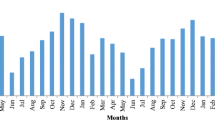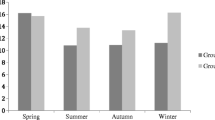Abstract
Populations of Rhipicephalus sanguineus, Dermacentor variabilis and Amblyomma maculatum with high and low oviposition capacities were successfully bred in the laboratory. Mating of male and female ticks which possess high oviposition capacity produced female progenies with high oviposition capacity; male and female ticks which possess low oviposition capacity produced female progenies which possess low oviposition capacity. Crossmatings of males with females of opposite oviposition capacity produced female progenies which acquired the category of oviposition capacity of the males in predominant numbers after fourth and Fifth generations. It is suggested that the genetic factor for high or low oviposition capacity is either possessed by male ticks alone or is stronger and dominant in the male over that of the female. This genetic factor is also potentiated by successive crossmatings of males and females possessing opposite oviposition capacities.
The possible application of these results to tick control through the suppression of natural population by field release of laboratory-bred populations of male ticks which possess low oviposition capacity is discussed.
Résumé
Des populations de Rhipicephalus sanguineus, Dermacentor variabilis et Amblyomma variegatum caractérisées par des pontes soit faibles soit fortes ont pu étre élévees en laboratoire. Le croisement de mâles et femelles à fortes ponte engendre une descendance femelle à fortes pontes tandis que le croisement d’individus à faibles pontes résulte en femelles peu productrices. La combinaison des deux traits opposés produit des femelles qui, après quatre ou cinq générations, héritent les caractéristiques de la population de mâles. Ceci suggère donc que le facteur génétique responsable de la taille des pontes se trouve, ou est dominant, chez le mâle, ou est en tout cas plus fort que celui de la femelle. Il ne s’exprime en outre qu’après le croisement répété de femelles et mâles de caractères opposés.
L’application pratique de ces résultats—suppression de populations naturelles par lâcher de mâles à facteur de ponte faible—est discuée dans le cadre de la lutte antitiques.
Similar content being viewed by others
References
Bailey K.P. (1960) Notes on the rearing of Rhipicephalus appendiculatus and their infection with Theileria parva for experimental transmission. Bull. Epizoot. Dis. Afr. 8, 33–43.
Balashov Y.S. (1972) Blood sucking ticks (Ixodidae) vectors of disease of man and animals. Misc. Publ. Entomol. Soc. Am. 8, 161–376.
Bram R.A. (1975) Tick-borne livestock diseases and their vector. I. The global problem. World Anim. Rev. 16, 1–5.
Brassard M. (1976) Relations immunologiques entre bovins et tiques, plus particulierement entre bovins et Boophilus microplus. Acta Trop. 33, 15–36.
Durand M.R.E. (1976) Ticks—a warning. Queensl. Agric. J. (Nov-Dec.) pp. 541–544.
Davey R.B. (1986) Mating competitiveness of hybrid Boophilus male ticks compared to pure-strain B. microplus males (Acari:Ixodidae). J. Med. Entomol. 23, 433–436.
Davey R.B., Osburn R.L. and Castillo C. (1983) Longevity and mating behaviour in males and parthenogenesis in females in hybridized Boophilus ticks (Acari:Ixodidae). J. Med Entomol. 20, 614–617.
Diehl P.A., Aeschlimann A. and Obenchain F.D. (1982) Tick reproduction: Oogenesis and oviposition. In Physiology of Ticks (Edited by Obenchain F.D. and Galun R.), pp. 277–350. Pergamon Press, U.K.
Dipeolu O.O. and Haruna A. (1984) Studies on ticks of veterinary importance in Nigeria. XVII. Resistance of rabbits to infestation with Amblyomma variegatum and Boophilus decolorants (Acari:Ixodidae). Folia Parasitol. 31, 357–364.
Dipeolu O.O., Amoo A.O. and Akinboade O.A. (1989) Studies on ticks of veterinary importance in Nigeria: Intrinsic factors influencing oviposition and egg-hatch of Amblyomma variegatum under natural conditions. Folia Parasitol. 35 (in press).
Dipeolu O.O. (1989) Studies on ticks of Alabama: Oviposition, egg sizes and shapes and embryonic development of Dermacentor variabilis, Rhipicephalus sanguineus and Amblyomma maculatum. Exp. Appl. Acarol. 5 (in press).
Ernst S.E. and Gladney W.J. (1974) Dermacentor albipictus: Hybridization of the two forms of the winter tick. Ann. Entomol. Soc. Am. 68, 63–67.
George J.E., Osburn R.L. and Wikel S.K. (1985) Acquisition and expression of resistance by Bos indicus and Bos indicus x Bos taurus calves to Amblyomma americanum infestation. J. Parasitol. 71, 174–182.
Gladney W. J. and Dawkins C.D. (1973) Experimental interspecific mating of Amblyomma maculatum and A. americanum. Ann. Entomol. Soc. Am. 66, 1036–1039.
Graham O.H., Price M.A. and Trevino J.L. (1972) Crossmating experiments with Boophilus annulatus and B. microplus (Acarina:Ixodidae). J. Med. Entomol. 9, 531–537.
Hewetson R.W. (1971) Resistance by cattle to cattle tick, Boophilus microplus III. Development of resistance to experimental infestation by purebred Sahiwal and Shorthorn cattle. Aust. J. Agric. Res. 22, 331–342.
Knipling E.F., Laven H., Craig G.B., Pal R., Kitzmiller J.B., Smith C.N. and Brown A.W.A. (1968) Genetic control of insects of public health importance. Bull. W. H. O. 38, 421–438.
Mongi A.O., Shapiro S.Z., Doyle J.J. and Cunningham M.P. (1986a) Immunization of rabbits with Rhipicephalus appendicular antigen-antibody complexes. Insect Sci. Applic. 7, 479–487.
Mongi A.O., Shapiro S.Z., Doyle J.J. and Cunningham M.P. (1986b) Characterization of antigens from extracts of fed ticks using sera from rabbits immunized with extracted tick antigen and by successive tick infestation. Insect Sci. Applic. 7, 479–487.
Osburn R.L. and Knipling E.F. (1982) The potential use of sterile hybrid Boophilus ticks (Acari: Ixodidae) as a supplemental eradication technique. J. Med. Entomol. 19, 637–644.
Solomon K.R. (1983) Acaricide resistance in ticks. Adv. Vet. Sci. Compedium Media. 27, 273–296.
Steelman C.D. (1976) Effects of external and internal arthropod parasites on domestic livestock production. Annu. Rev. Entomol. 21, 155–178.
Thompson G.D., Davey R.B., Osburn R.L. and Cruz D. (1980) Longevity and fertilization capacity of males and parthenogenesis in females of Boophilus annulatus and B. microplus. J. Econ. Entomol. 73, 378–380.
Thompson G.D., Osburn R.L., Davey R.B., Drummond R.D. and Price M.A. (1981a) Hybrid sterility in cattle ticks (Acari:Ixodidae). Experientia 37, 127–128.
Thompson G.D., Osburn R.L., Davey R.B. and Price M.A. (1981b) The dynamics of hybrid sterility between Boophilus annulatus and B. microplus (Acari:Ixodidae) through successive generations. J. Med. Entomol. 18, 413–418.
Utech K.B.W., Seifert G.W. and Wharton R.H. (1978) Breeding Australian Illawara Shorthorn cattle for resistance to Boophilus microplus I. Factors affecting resistance. Aust. J. Agric. Res. 29, 411–422.
Weidheis D.E., Haile D.G., George J.E., Osburn R.L. and Drummond R. (1983) A basic model for use in computer simulations of Boophilus tick biology and control. USDA, ARS. Advance Agricultural Technology. AAI-S-32.
Wharton R.H. (1976) Tick-borne livestock diseases and their vectors. 5. Acaricide resistance and alternate method of tick control. World Anim. Rev. 20, 8–15.
Wharton R.H. and Roulston W.J. (1970) Resistance of ticks to chemicals. Annu. Rev. Entomol. 15, 381–404.
Whelen A.C., Richardson L.K. and Wikel S.K. (1984) Ixodid tick antigens recognized by the infested host: Immunoblotting studies. IRCS Med. Sci. 12, 910–911.
Wikel S.K. and Osburn R.L. (1982) Immune responsiveness of the bovine host to repeated low-level infestations with Dermacentor andersoni. Ann. Trop. Med. Parasitol., 76, 405–414.
Wikel S.K. and Whelen A.C. (1986) Ixodid-host immune interaction. Identification and characterization of relevant antigens and tick-induced host immunosuppression. Vet. Parasitol. 20, 149–174.
Winston P.W. and Bates D.H. (1960) Saturated solutions for the control of humidity in biological research. Ecology 41, 232–237.
Author information
Authors and Affiliations
Rights and permissions
About this article
Cite this article
Dipeolu, O.O. Evidence of Heredity in Oviposition Capability of Ticks. Int J Trop Insect Sci 10, 591–599 (1989). https://doi.org/10.1017/S1742758400021718
Received:
Revised:
Published:
Issue Date:
DOI: https://doi.org/10.1017/S1742758400021718
Key Words
- Ticks
- heredity
- oviposition capacity
- mating
- generations
- genetic factors
- Rhipicephalus sanguineus
- Dermacentor variabilis
- Amblyomma maculatum




